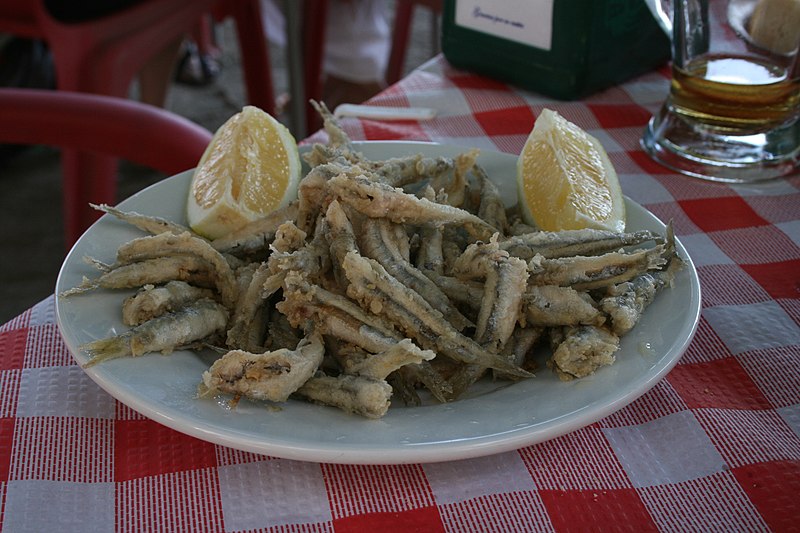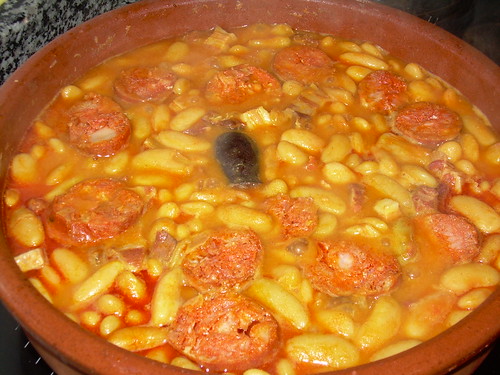I wrote this for a vegetarian who was visiting Madrid:
Spanish fish
In general, restaurants in Madrid serve very fresh fish. Galician (“gallego”) restaurants are usually a good choice for all kinds of seafood, as are Basque (“Vasco”) and Asturian restaurants.
Besugo: Bream
Dorada: Golden bream(?)
Lubina: Bass
These fish are all highly appreciated and are usually caught locally and served whole. Often served “a la espalda” (baked and then drizzled with garlic and oil) or “a la sal” (The fish is completely encased in rock salt and roasted. The salt is then broken open, and if it is done properly the fish does not taste salty at all, but is very tender and moist.)
Spanish fish
In general, restaurants in Madrid serve very fresh fish. Galician (“gallego”) restaurants are usually a good choice for all kinds of seafood, as are Basque (“Vasco”) and Asturian restaurants.
Besugo: Bream
Dorada: Golden bream(?)
Lubina: Bass
These fish are all highly appreciated and are usually caught locally and served whole. Often served “a la espalda” (baked and then drizzled with garlic and oil) or “a la sal” (The fish is completely encased in rock salt and roasted. The salt is then broken open, and if it is done properly the fish does not taste salty at all, but is very tender and moist.)
Besugo
Trucha: trout
Always good, and often the cheapest dish on the menu. “Trucha a la Navarra” is pan-fried with a piece of bacon or ham inside.
Boquerones: fresh anchovies (not salty like canned anchovies)
Boquerones al vinagre are pickled in brine (called “white anchovies” in places like Zabar’s). Often served as inexpensive tapas in bars. Boquerones fritos are very delicious, a good choice at low end restaurants and a favorite among children.
Sardinas: fresh sardines, bigger than boquerones, served fritas or asadas (grilled). Inexpensive and healthy, often eaten with the hands.
boquerones fritos
Merluza: hake (like cod, but a bit firmer).
This may be the most common fish in Spain, usually served in “steaks”. “Merluza a la gallega” baked in a casserole with potatoes, is my favorite.
Lenguado: sole
Rodaballo: flounder(?)
Mero: grouper
Pescado en adobo, cazon en adobo, et al: Small chunks of fish, marinated in lemon juice and other seasonings, then breaded and fried. This is a specialty in the south, where it is always good. In Madrid, it’s more hit or miss (like getting soul food in New York). Good at La Giralda, not bad at La Trucha off Plaza Santa Ana.
There are several words for squid:
Calamares: deep fried rings of squid (what you’re used to)
Chopitos: tiny little baby squid, usually fried
Chipirones: small-medium squid, sometimes served whole “a la plancha” (cooked on hot metal—basically on a griddle with a little oil).
Gambas, gambones, camarrones, langostinos (there are some other words as well): shrimp. Usually served with the shells on, even in paella; peel them with your hands.
Pulpo: Octopus. Pulpo a la gallega=pulpo a la feira. A classic dish from Galicia, boiled octopus, cut in slices and drizzled with olive oil, pimenton (paprika) and salt. Makes a great snack with a glass of white wine or beer.

pulpo a la gallega / pulpo a la feira
Emperador=pez espada=swordfish
Usually served “a la plancha” sliced much thinner than in the US, and cooked quickly.
Percebes: goose barnacles. These come from Galicia and are considered a great delicacy. You should try them if you get a chance, because you won’t get anything like them in the US.
Almejas: clams
Mejillones: mussels
Vieiras: scallops, usually served in the shell.
Ostras: oysters. They exist, but are not so common
There are a million different kinds of shellfish; I only know some of them.

cigalas -- don't miss this (if you can afford it)
Vegetables, etc.
The usual word for vegetable is “verdura”.
Ensalada mixta: standard lettuce & tomato salad, usually contains some canned tuna, olives, asparragus, etc.
Acelgas: Swiss chard, this is one of the most common green vegetable. Usually served“rehogadas”, which means sauteed with garlic and oil.
Pimientos de padron: A galician specialty, these are small green peppers, served roasted; about every tenth one is spicy, the rest are mild.
Gazpacho is usually very good, but most restaurants stop serving it when the weather gets cold. Salmorejo is a thick Andalusian version of gazpacho, topped with a little hard boiled egg and chopped serrano ham.
Judias verdes=green beans.
Some restaurants have a “parrillada de verduras”, which is a plate of mixed grilled vegetables, good for sharing.
Lentejas: lentil soup. Very typical everyday food. Almost always contains some pork product like chorizo. Usually very good if you can get past the meat.
Beans are often called judias, judiones, alubias, habas, fabes. Never frijoles or habichuelas—these are Latin American terms. Most bean dishes contain some meat products—usually pork. If you can tolerate it, they tend to be very good. My favorite is fabada asturiana—made with white beans. Another Asturian specialty is fabes con almejas: white beans with clams. Judiones de la granja is a Segovian specialty made with very large white beans. Spanish bean dishes are usually not served with rice.
Plátano simply means banana.
Every restaurant will have some fresh fruit or yogurt for dessert. Other common choices are flan, natillas (custard), crema catalana (crème brulee), arroz con leche (rice pudding), tarta de queso (cheese cake), tarta de zanahoria (carrot cake).
Tortilla=omelette (they don’t even know what a Mexican tortilla is). Tortilla de patata is ubiquitous—very filling and delicious, good with beer, wine or coffee. In almost any bar or cafeteria you can get a “pincho de tortilla” which is a small portion of potato omelette with a piece of bread—a stand by for many vegetarians.
In any cafeteria you can get:
Café con leche, café solo (expresso), café cortado (expresso with a dash of milk), té, manzanilla (chamomile), menta poleo (spearmint tea), una caña (a small draft beer), una copa de vino tinto, una copa de vino blanco, un agua mineral con o sin gas, una coca cola, una fanta de naranja o limon, un zumo de naranja, etc.






2 comments:
Perfect. I´m spanish, I speak english as my cleaning-machine, and I have to tell you that you are a great spanish gourmet.
One thing: platano is not exactly a banana: platano is the most common fruit from Islas Canarias. Platano is littler, sweeter. We only use bananas for cooking "arroz a la cubana" (rice, tomato, fried eggs ans sometimes banana fried).
I´m impressionate about your knowledges about our cuisin. Thanks.
Thanks very much for the comment. Maybe I'll add "arroz a la cubana" to the post. What does this mean: "I speak english as my cleaning-machine..." ??
Gracias por las palabras amables. Saludos.
Post a Comment